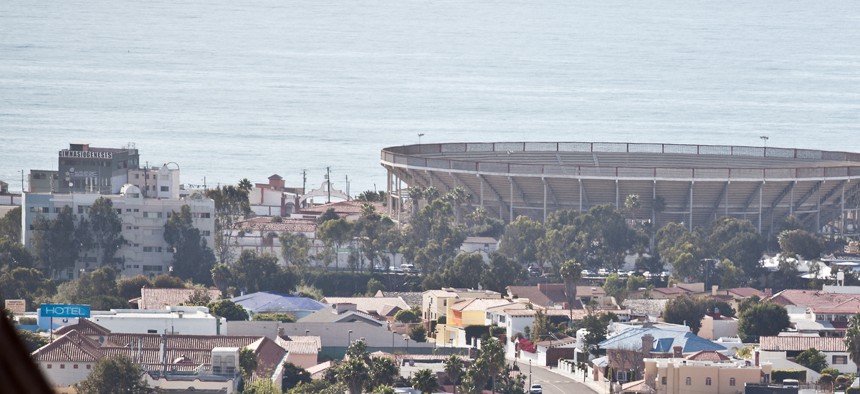
The U.S.-Mexico border, with Tijuana on the left, and the U.S. on the right. Customs and Border Protection
The US Doesn’t Know How Secure Its Border Is
Without one critical metric, it's hard to make accurate statements on how efficient the U.S. Border Patrol is -- or how a new bill would improve border security.
It's been called the "toughest border-security bill ever."
Rep. Michael McCaul's Secure Our Borders First Act will be voted on in the House next week, and it requires the Homeland Security Department to construct 400 miles of new roads and more than 100 miles of new border fences. It deploys new technology such as a biometric exit system at ports of entry and directs more air power to track migrants. It also requires DHS to disclose more data on how safe the border is.
But as the House risks putting divisions within its own ranks on display and goes head-to-head with the Obama administration, it's worth asking: How secure are the 2,000 miles that stretch from California to Texas today to begin with?
There's only one problem -- nobody can tell you.
(Related: America's Border Drones Are Costly and Ineffective, Watchdog Finds)
Along the border, there are records and metrics of how many Border Patrol agents are on the clock every year, how many migrants are caught illegally crossing into the United States, and how much money is being spent securing the border, but those numbers give merely a slice of the picture. There is no way to know for sure the answers to the bigger questions: How many individuals cross in total? And, how many of them slip by without detection?
"We know the amount of resources that have been invested," says Doris Meissner, a former commissioner at what was then the U.S. Immigration and Naturalization Service and a senior fellow at the Migration Policy Institute. "What we don't have is outcomes. How do we know what our return on investment is?"
Congress allocates more money to enforcing immigration laws through agencies like Customs and Border Protection and Immigration and Customs Enforcement than it does on the FBI, the Drug Enforcement Administration, the Secret Service, the U.S. Marshals Service, and the Bureau of Alcohol, Tobacco, Firearms, and Explosives combined. In 1992, CBP had just over 4,000 Border Patrol agents. In 2014, it had 20,863, and with more agents comes a ballooning budget bringing the cost of CPB up from $2.6 million in the early 1990s to $3.6 billion in 2014.
That's a lot of money to be spending without a clear understanding of the results.
Every agency has its own way of marking progress. The Border Patrol, for example, keeps records on the number of immigrants it catches entering the U.S. illegally. That number was up slightly over the last year at 479,371 – due in large part to a surge in unaccompanied minors from Central America. But, compared to a high-water mark in 2000 when more than 1.6 million immigrants were caught, the border appears to be far more secure than it was just over a decade ago.
But without knowing how many immigrants are actually slipping across the border undetected, it is hard to make accurate statements on how efficient the Border Patrol actually is. When it comes to making policy, that is a big hurdle, advocates says.
"It is a political problem, because it does allow for all kinds of rhetoric and for mischaracterizing the degree of enforcement that is actually taking place," Meissner says. "It allows politicians to claim that unless the border is free of any kind of crossing that somehow enforcement is failing."
Uncertainty has allowed contradictory narratives to overshadow the immigration debate in Washington. In one, the Obama administration asserts, "Our borders now are more secure than they have ever been in history." In another, Republican border hawks in the House Conference make passing sweeping immigration reform legislation nearly impossible with claims that a porous border is making the U.S. susceptible to outbreaks of Ebola and and invasion from ISIS fighters.
McCaul's bill tries to tackle some of the gaps in border data that are available. The legislation would require DHS to disclose more metrics so Congress could better allocate resources to the sectors that need them most.
"We need to get away from an attitude of more, more, more and move to an attitude of an efficient use of the resources," says Christopher Wilson, the senior associate at the Mexico Institute of the Woodrow Wilson International Center for Scholars.
Under the law, DHS officials would have to disclose the rate of drug seizures, response rates, and a border-crossing rate. But the metrics will not be used just to measure progress. The numbers will also be used to assert "operational control" of the border. That means the data would be used to hold DHS accountable if the Border Patrol had not prevented "all unlawful entries into the United States, including entries by terrorists, other unlawful aliens, instruments of terrorism, narcotics and other contraband" within five years.
Without knowing where we are now, many border experts say it's not a realistic goal. In fact, it may never be possible.
"Anytime you talk about the border now, you have to compare it to what it used to be. It is in good shape, and it always needs to get better," says David Aguilar, deputy commissioner for U.S. Customs and Border Protection, who now serves as a partner at Global Security and Intelligence Strategies. "This bill calls for operational control of the border. It is not practical to do that under its current definition."
NEXT STORY: Is This the Twilight of Saudi Power?




